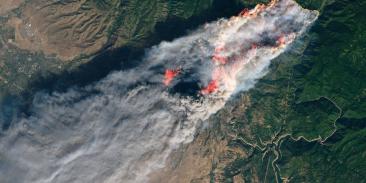EDF, Google Use Special Mapping Cars to Help Alabama’s Top Gas Utility Identify and Measure Leaks from Birmingham Natural Gas System
Interactive Maps Show Leak Size, Location with Increased Precision; Technology Can Accelerate System Upgrades, Quantify Climate Risk
(BIRMINGHAM, AL – November 1, 2017) Environmental Defense Fund and Google Earth Outreach today released online maps showing the location and size of methane leaks from natural gas pipes beneath the streets of Birmingham, Alabama. The maps were created using Google Street View mapping cars specially equipped with technology developed by EDF, Google and Colorado State University, and are designed to showcase new technologies to help operators prioritize costly pipeline repair and replacement efforts.
The utility company Spire (formerly Alagasco), which owns the pipes, has been working to replace aging, leak-prone lines throughout its system. Leaks like the ones mapped by the team don’t usually pose an immediate safety threat, but small leaks can add up. And the escaping gas – which is mostly methane – has a powerful effect on the climate, packing 84 times the warming effect of carbon dioxide over a 20-year timeframe. Spire has 1.7 million customers across Alabama, Missouri, and Mississippi.
“Methane leaks are a challenge in cities across the country, especially where they have aging infrastructure. It’s a loss of customer resources, a waste of national resources, and a serious environmental challenge,” said Jonathan Peress, EDF Policy Director for Climate and Energy. “Replacing old, leaking pipes is an important opportunity to save resources and cut greenhouse emissions quickly. New data like this can help get the job done in a way that’s better for ratepayers and the environment alike.”
The Birmingham maps are online at www.edf.org/climate/methanemaps.
A video on the project is at http://tinyurl.com/MethaneMaps.
The Street View mapping cars collected hundreds of thousands of readings over 345 miles of roadway in selected areas of the city from March to May this year, identifying 168 leaks – in line with expectations for a system the age of Birmingham’s. Spire has about 900 miles of pipe made from cast iron, bare steel, and other leak-prone materials. About 40% of their pipes were installed before 1970.
From 2015 to 2016, Spire cut its backlog of known leaks in pipes by 38 percent and reduced their mileage of cast iron pipeline mileage by nine percent. Despite this progress, Alabama still ranks in the top states for miles of leak-prone pipe. Created from data taken over a period of months, the maps don’t paint a real-time picture. But they do reflect conditions facing Spire and dozens of other utilities, particularly in older cities.
“Safety is core to who we are at Spire, and we’re always looking at new technology to do even better,” said Bob Gardner, Director of Compliance and Pipeline Integrity, at Spire. “That’s why we are coordinating efforts with EDF and Google Earth Outreach to test advanced detection and measurement technology in the communities we serve in central Alabama.”
All utilities are required by law to monitor their lines and immediately fix leaks that pose a safety threat. But other leaks can and often do go undetected or unrepaired for long periods. Over time, the emissions add up.
The leak detection and measurement technology used in this project is more sensitive than utilities typically use, generating far more information than most operators now collect. It is designed to measure the quantity of gas leaking, which traditional survey methods don’t do. The software used in Birmingham is the latest version yet deployed by the team, allowing for greater precision than cities mapped earlier in the project.
“We are excited that Google technology can play an important role here, to power the measurement, analysis, and communication of environmental information,” said Karin Tuxen-Bettman, Program Manager for Google Earth Outreach. “Making this information more accessible can make a meaningful difference in people’s lives.”
“The opportunity to deploy this unique technology allows us to better understand issues facing our city’s energy infrastructure,” said Christina Andreen, staff attorney for the Southern Environmental Law Center’s Birmingham office. “Access to this data helps to prioritize replacement of the leakiest pipes throughout Birmingham, which is a win across the board for the customer, utility and environment.”
Utilities in New York and California are already publishing dynamic maps of their natural gas leaks. Sharing geographically-attributed leak data can help regulators and customers track utilities’ leak management performance, and ensure cost-efficient emission reductions. In New Jersey, the state’s largest utility is using data collected by EDF and Google Earth Outreach to maximize the environmental benefits of a $905 million pipeline replacement program.
The team from EDF and CSU spent five years developing and testing their methodology — both the technology and data analysis — proving that it could deliver accurate results in real-world conditions. Calculations were tested for accuracy against controlled experiments using known concentrations of gas, and the researchers conducted validation studies with utility data on leak locations. The system is much more sensitive than those currently used in safety monitoring.
In the cities we’ve mapped for this project, the team has worked closely with both the primary gas utility and relevant local regulators to share the data and validate their findings.
With more than 3 million members, Environmental Defense Fund creates transformational solutions to the most serious environmental problems. To do so, EDF links science, economics, law, and innovative private-sector partnerships to turn solutions into action. edf.org
Media Contact
Latest press releases
-
Trump Administration’s New Tax Credit Guidance Is “Another Senseless Attack on Clean Energy”
August 15, 2025 -
More Dire Colorado River Reservoir Forecasts Reinforce Urgent Need for Action
August 15, 2025 -
EDF, UCS Ask Court to Enjoin Trump Administration’s Brazenly Unlawful Use of Corrupt “Science” Report
August 15, 2025 -
Independent Report Finds that the Trump Administration’s Orders to Keep Coal-fired Power Plants Running Could Cost Consumers between $3-6 Billion a Year
August 14, 2025 -
EDF Strongly Opposes Trump Administration Proposals to Eliminate Protections for Air Pollution from Power Plants
August 13, 2025 -
Some Truck Makers Challenge Vital Clean Truck Partnership with California
August 12, 2025










